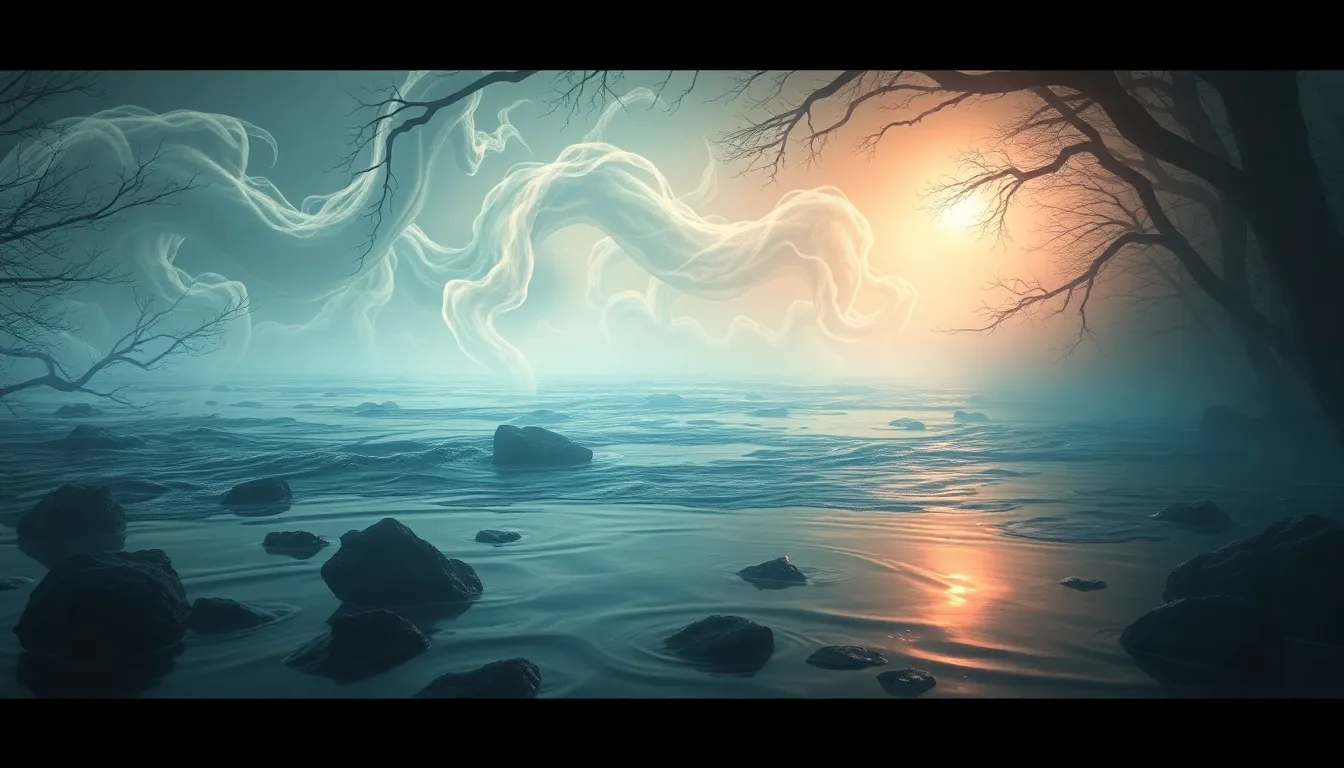The River of Spirits: Myths of Ghostly Waters
I. Introduction
Water has always held a special place in the hearts and minds of humanity, serving not only as a vital resource for life but also as a powerful symbol in mythology and folklore. From ancient civilizations to modern cultures, rivers and bodies of water have been imbued with meanings that go beyond their physical properties, often representing the boundary between the known and the unknown.
In many cultural narratives, rivers are more than mere waterways; they are sacred pathways that connect the realms of the living and the dead. This article explores the concept of “ghostly waters,” examining how rivers have been depicted as conduits for spirits, places of transformation, and sites of mythological significance.
II. The Historical Context of Water Myths
A. Ancient Civilizations and their Water Deities
Throughout history, ancient civilizations have revered water deities, believing that these entities governed the life-giving properties of rivers and seas. For instance:
- In ancient Egypt, the goddess Hapi personified the Nile, symbolizing fertility and abundance.
- In Mesopotamia, the god Enki was associated with freshwater and was believed to bring wisdom and life.
- The Greeks worshipped Poseidon, the god of the sea, who was often depicted as a powerful figure commanding the waters.
B. The Role of Rivers in Spiritual Beliefs
Rivers have served as important symbols in many spiritual beliefs. They are often seen as sacred spaces where the physical and spiritual worlds intersect. Rituals and offerings are frequently made at riverbanks to appease the spirits believed to inhabit these waters.
C. Transition from Utility to Mythology
Initially, rivers were primarily viewed as practical resources for transportation, agriculture, and survival. However, as societies evolved, the spiritual and mythological aspects of rivers gained prominence, transforming these waterways into significant cultural symbols.
III. The Symbolism of Rivers in Folklore
A. Rivers as Life Sources and Thresholds
In folklore, rivers often symbolize life, serving as sources of nourishment and sustenance for communities. However, they also represent thresholds between different states of existence, such as life and death.
B. The Dichotomy of Life and Death in Water Myths
This duality is evident in many myths where rivers can be both nurturing and dangerous. Floods may bring destruction, while calm waters can represent peace and tranquility.
C. Rivers as Pathways to the Afterlife
Many cultures believe that rivers serve as pathways to the afterlife. For example, the act of crossing a river may symbolize a soul’s journey to the next world.
IV. Prominent Myths of Ghostly Waters
A. The River Styx: Greek Mythology and the Underworld
In Greek mythology, the River Styx is a key feature of the underworld, separating the living from the dead. Souls must cross the Styx, often ferried by Charon, to reach their final resting place.
B. The Sanzu River: Japanese Beliefs in the Afterlife
Similarly, in Japanese culture, the Sanzu River is believed to be a boundary between the world of the living and the afterlife. Souls are said to traverse this river, facing trials that determine their fate.
C. The Nile: Egyptian Myths and the Journey to the Afterlife
The Nile River plays a crucial role in Egyptian mythology, where it represents the cycle of life, death, and rebirth. The journey along the Nile is often depicted in funerary texts, guiding the deceased toward the afterlife.
V. Regional Variations of Water Spirits
A. The Nymphs and Naiads of European Folklore
In European folklore, water spirits such as nymphs and naiads are often depicted as guardians of rivers and lakes, embodying the beauty and danger of water. They are known to lure unsuspecting travelers to their doom.
B. The Water Spirits of African Traditions
African traditions feature a rich tapestry of water spirits, often considered protectors of rivers and lakes. These spirits are invoked in rituals for fertility and prosperity.
C. Indigenous North American Water Beings
Indigenous cultures in North America have their own unique water beings, such as the Water Man of the Ojibwe, who embodies the spirit of the water and is revered for his role in maintaining balance in nature.
VI. Modern Interpretations of Water Myths
A. Ghost Stories and Urban Legends about Rivers
In contemporary culture, rivers continue to be the setting for ghost stories and urban legends. Tales of haunted rivers often reflect societal fears and the unknown aspects of nature.
B. Depictions in Literature and Film
Water myths have also found their way into literature and film, influencing works that explore themes of loss, memory, and the passage of time.
C. The Influence of Contemporary Culture on Traditional Myths
Modern interpretations of water myths often blend traditional beliefs with contemporary issues, creating new narratives that resonate with today’s audiences.
VII. The Psychological and Emotional Aspects of Water Myths
A. Fear and Fascination with Water as the Unknown
Water evokes a complex emotional response, representing both fear and fascination. This duality is a common theme in water myths, reflecting humanity’s relationship with the unknown.
B. Healing and Catharsis in Water Rituals
Many cultures incorporate water rituals for healing and catharsis, symbolizing purification and renewal.
C. The River as a Metaphor for Human Experience
Metaphorically, rivers represent the journey of life, with its twists, turns, and inevitable passage toward the end.
VIII. Environmental Concerns and Their Impact on Water Myths
A. Climate Change and the Transformation of Water Bodies
Environmental changes, particularly climate change, have significant effects on rivers and water bodies, altering their physical and spiritual significance in cultures worldwide.
B. The Disappearance of Myths in Relation to Vanishing Rivers
As rivers disappear or change, so too do the myths associated with them, leading to a loss of cultural heritage and spiritual narratives.
C. Conservation Efforts and the Revival of Water Traditions
Efforts to conserve rivers can lead to a revival of water traditions, fostering a renewed appreciation for the myths and stories that celebrate these vital waterways.
IX. Preserving the Legacy of River Myths
A. Oral Traditions and Storytelling Practices
Oral traditions play a crucial role in preserving river myths, allowing stories to be passed down through generations and keeping cultural narratives alive.
B. The Role of Education in Keeping Myths Alive
Educational initiatives can help raise awareness about water myths, encouraging the appreciation of diverse cultural perspectives on rivers and water spirits.
C. Celebrating Rivers Through Cultural Festivals
Cultural festivals dedicated to rivers often celebrate their significance, featuring rituals, storytelling, and community gatherings to honor the myths and traditions associated with these waterways.
X. Conclusion
In summary, the myths surrounding rivers and ghostly waters illustrate the profound connection between humanity and the natural world. From ancient deities to modern interpretations, these stories reflect our fears, hopes, and the enduring mystery of water. As we confront environmental challenges, it becomes increasingly important to preserve these myths, ensuring that the legacy of our rivers continues to flow through time.



